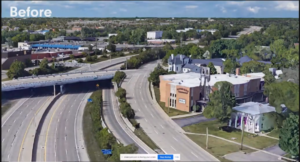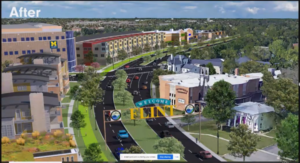By Coner Segren
An ambitious proposal to fill in the 12-lane I-475 through downtown Flint and replace it with 30 acres of land open to development was introduced to the public at a virtual town hall Wednesday hosted by Mayor Sheldon Neeley and his chief of staff Brian Larkin.
Neeley and Larkin are seeking community input on possibilities renovation of the freeway, under consideration because of of new state funds available to Flint from the Michigan Department of Transportation (MDOT).
The funds would allow the city to repave a portion of the interstate going through downtown, specifically the segment stretching from 5th Street to Kearsley including Chavez Drive.

A photograph of the present I-475 and Chavez Drive in downtown Flint. (Photo provided by the City of Flint)
A chance to bind old division?
Neeley said he sees the project as a chance to bind old divisions in the city. “It was first in 1973 when I-475 first opened, dividing one of our historic black communities,” he said, “and this is one of the first steps to rejoining some of those activities.”
MDOT is assessing the feasibility of extending the renovations from Court Street to Davison Road and creating a boulevard in place of the current expressway.
The objectives of the proposal, according to Larkin, are to reconnect the Cultural Center and Mott Community College with downtown, as well as to connect Kearsley Park with the Flint River and its corresponding system of trails. The renovation would also open space for an expansion of UM-Flint and the creation of a new trail.
Enabling a “Slower, more pedestrian-friendly pace”
The proposed renovation would mean shrinking the twelve lanes going north and south to four lanes, which Larkin argued would create a slower, more pedestrian-friendly pace.
“As we think about connecting community, it’s not just the individuals, but how the individuals move,” Larkin said. “Multiple forms of transportation, walking, crosswalks, biking, bike lanes, all of that is much more accessible when traffic is moving at slower speeds.”

The proposal is preliminary, Larkin said. A feasibility study has yet to be done by MDOT to determine the effect the renovation would have on traffic and safety. Larkin stressed that if the project does not meet those standards, it will not go ahead
“Replacing I-475 with a more pedestrian-friendly road could make it easier for people to navigate the city,” Larkin said.
“One of the things we do know with the existing data is that a good portion of the traffic that are using 475 are not using it to make it all the way to the other end of the highway– they’re using it to make local stops,” Larkin said, “so if you’re using 475 to go to different local locations, bringing this down to a slower grade will only assist you in getting into the city.”
“Great things for economic development”
Several panelists joined the discussion virtually.
Panelist George Wilkinson, pastor at Word of Life Christian Church and president of Northgate Packaging, said he was enthusiastic about the economic potential.
“When I look at this from a business opportunity, anytime you revitalize, reconnect and reposition a community the way [Larkin] has here, I think it’s going to do great things from an economic development perspective,” Wilkinson said.
Rick Sadler, assistant professor at the College of Human Medicine at Michigan State University, said he believed the potential renovation could have the effect of making transportation in the city more just.
Making transportation “more socially just”
“I see it as a piece of a broader transportation strategy that is making our transportation network more socially just,” Sadler said.
“I think of the road diets on Dupont and Fenton and the new one going up on Atherton Road and the fact that those are making it easier for people to get around… the fact that people will be able to experience their community in a more calm and pleasant way, and that itself will be a catalyst for new investment.”
Ultimately, though, both Larkin and Neeley made clear that any forward movement on the project would be contingent on the wishes of the city of Flint and the communities who would be affected, as well as availability of resources.
“I want to reiterate the point of this is the beginning; if this is something embraced by the community, that’s viewed as positive, and we definitely want it, the next step is to ask ‘what does this look like?’” Neeley said. “Anything is on the table, but it needs to be shaped by the needs of the community directly, and the resources, and what the engineering specifications say.”
For those wishing to give feedback on the potential project, more town halls on the subject are forthcoming, Neeley stated. Town halls are expected to continue to take place virtually on Facebook and YouTube.
EVM staff writer Coner Segren can be reached at csegren@umich.edu.


You must be logged in to post a comment.